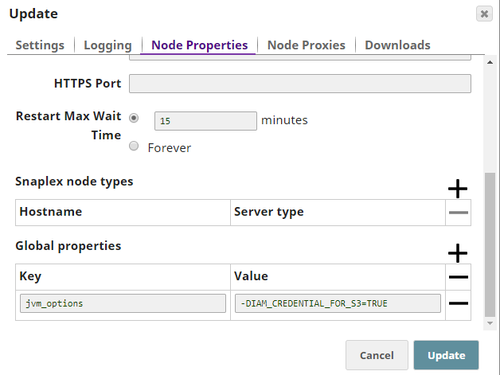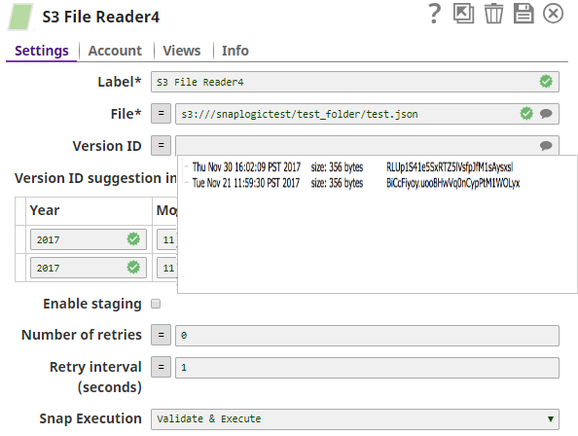On this Page
| Table of Contents | ||||
|---|---|---|---|---|
|
Overview
...
Snap Type:
...
Read
...
Description:
...
The S3 File Reader Snap reads data from an S3 bucket.
...
When you provide a Version ID
...
,
...
the Snap reads a specific version of an S3 file object.
...
| Multiexcerpt include macro | ||||||||
|---|---|---|---|---|---|---|---|---|
|
Input & Output
Expected input: An upstream Snap is optional and any Snap with a document output view can be connected upstream (such as Mapper, File Writer, and so on). Any document with key-value pairs to evaluate expression properties in the S3 File Reader Snap. Each input document, if any, will cause one read operation of the Snap.
Expected output: Any Snap with a binary input view can be connected downstream, such as CSV Parser, JSON Parser, XML Parser, and so on. Binary data read from AWS S3 specified in the File property with header information about the binary stream. The binary data and header information can be previewed at the output of the Snap. An example is:
...
| Paste code macro | ||
|---|---|---|
| ||
{
"content-length": "96258"
"last-modified": {
"_snaptype_datetime": "2014-06-26T23:27:01.000 UTC"}
"content-disposition": "attachment; filename="leads.csv""
"content-location": "s3:///mr_test/leads.csv"
"content-type": "text/csv"
"etag": "730145bec198288e9f428193fde851b7"
} |
...
Snap Type
The S3 File Reader Snap is a Read-type Snap that reads the any type of data from S3 bucket.
Prerequisites
IAM Roles for Amazon EC2
The IAM_CREDENTIAL_FOR_S3 feature is to access S3 files from Groundplex nodes hosted in the EC2 environment
...
. No Access-key ID and Secret key in the AWS S3 account
...
is needed.
The IAM credential stored in the EC2 metadata provides access rights to the S3 buckets.
Learn more about IAM Roles for Amazon EC2.
| Expand | ||
|---|---|---|
| ||
|
...
|
...
|
...
|
...
IAM role is supported only in the Groundplex nodes hosted in the EC2 environment.
The IAM Role stored on the EC2 instance requires List, Read, and Write permissions.
S3 account validation is not supported when you enable IAM role property.
For more information on IAM Roles, see IAM Roles for Amazon EC2.
...
Support and Limitations
Support for Ultra Pipelines
Works in Ultra Pipelines.
...
Limitations
The current Snap functionality supports AWS S3 Cloud Service and will be applicable for AWSGovCloud setup.
...
Configurations
Account & Access
This Snap uses account references created on the Accounts page of SnapLogic Manager to handle access to this endpoint. See Configuring Binary Accounts for information on setting up accounts that work with this Snap.
Required settings for account types are as follows:
AWS S3 - Access-key ID, Secret key, Security token.
S3 Dynamic - Access-key ID, Secret key, Security token, Server-side encryption.
Views
| Input | This Snap has at most one document input view. |
|---|---|
| Output | This Snap has exactly one binary output view. |
| Error | This Snap has at most one document error view and produces zero or more documents in the view. |
...
Troubleshooting:
...
The section describes typical issues you may encounter while using this Snap, and instructions on how to workaround them:
...
Settings
...
Label
...
Required. The name for the Snap. You can modify this to be more specific, especially if you have more than one of the same Snap in your pipeline.
...
File
...
Required. This property specifies the URL for the S3 file, from where the binary data is to be read. It must start with "s3:///". The suggest feature can be used to view the list of buckets, subdirectories and files. Bucket names are suggested if the property is empty or "s3:///". Once a bucket is selected, it can list subdirectories and files immediately below the bucket. Names of subdirectories end with a forward slash ("/"). The suggest feature is not supported if the properties in the S3 Dynamic account are parameters.
This Snap supports S3 Virtual Private Cloud (VPC) endpoint.
| Note |
|---|
PrerequisiteThe provided account must have 'read' access to the specified S3 bucket in order to read the file successfully. |
Using Expressions:
This property can be an expression with the "=" button pressed.
For example, if the File property is "s3:///mybucket/out_" + Date.now() + ".csv" then the evaluated filename is s3:///mybucket/out_2013-11-13T00:22:31.880Z.csv.
Syntax:
| Paste code macro |
|---|
s3:///<S3_bucket_name>@s3.<region_name>.amazonaws.com/<path> |
For region names and their details, see AWS Regions and Endpoints.
| Note |
|---|
Region NameRegion name is optional only if the region is us-east-1. In all other cases the region name must be specified based on the syntax above. For example, mybucket@eu-west-1. See AWS Regions and Endpoints for details. |
| Multiexcerpt include macro | ||||
|---|---|---|---|---|
|
| Multiexcerpt include macro | ||||
|---|---|---|---|---|
|
Examples:
s3:///mybucket@s3.eu-west-1.amazonaws.com/test.json
s3:///rds-sql-test-staging@s3.us-gov-east-1.amazonaws.com/test.csv
_filename (A key/value pair with "filename" key should be defined as a pipeline parameter)
$filename (A key/value pair with "filename" key should be defined the input document)
VPC:
Default value: s3:///
...
Version ID
...
Enter or select S3 file version ID. If the property is empty, the Snap reads the latest version. The suggest feature can be used to view the list of version IDs for the S3 file in the File property. The suggest feature is not supported if the properties in the S3 Dynamic account are parameterized. Each line in the suggested list also includes the last modified date and the file size to help select a version. When the property value is entered manually, only the version ID is needed. The Snap ignores the last modified date and size information of a version when it reads the file. If the versioning of a S3 bucket is not enabled, no version ID is suggested. The versions of the following cases will be omitted in the suggested list since their files cannot be downloaded:
If a file had existed before the versioning was enabled, its version does not have any version ID assigned to it.
Version ID's with 'Deleted Marker' resource type are also omitted in the suggested list.
Examples: xvcnB8gPi37l3hbOzlsRFxjVwQ.numQz
Default value: [None]
...
Version ID suggestion interval
...
Enter the time interval for the Version ID suggestion. Enter two rows to provide a start date and an end dates. If only one row is provided, the interval will be from the date until now. If empty, all version IDs will be suggested. This property may be useful when a given S3 file has many versions. This property is used for the Version ID suggestion only, and not used during the Snap preview or execution.
...
Year
...
Enter the year as a 4-digit integer.
Example: 2017
Default value: [None]
...
Month
...
Enter the month as an integer.
Examples: 9, 09, 12, and so on.
Default value: [None]
...
Date
...
Enter the day of the month.
Examples: 28, 09, 12, and so on.
Default value: [None]
...
Zone
...
Enter or select a time zone ID from the suggested list. May be empty for UTC. Please note only zone IDs in the suggested list are supported.
Examples: US/Pacific
Default value: [None]
...
Enable staging
If selected, the Snap downloads the source file into a local temporary file. When the download is completed, it streams the data from the temporary file to the output view. This property prevents the Snap from being blocked by slow downstream pipeline. The local disk should have sufficient free space as large as the expected file size.
Default value: Not selected
| Note |
|---|
Some Snaps may take a long time to process large amounts of data. This, in turn, could lead to connection timeouts, causing the pipeline to fail. Selecting this property saves the data on your local disk, enabling you to avoid such timeouts. |
...
Number of retries
Specifies the maximum number of retry attempts that the Snap must make in case there is a network failure, and the Snap is unable to read the target file.
If the value is larger than 0, the Snap overrides the Enable staging value to true and downloads the S3 file to a temporary local file. If any error occurs during the download, the Snap waits for the time specified in the Retry interval and attempts to download the file again from the beginning. When the download is successful, the Snap starts to stream the data from the temporary file to the downstream Pipeline. All temporary local files are deleted when they are no longer needed.
| Info |
|---|
Ensure that the local drive has sufficient free disk space to store the temporary local file. |
Example: 3
Minimum value: 0
Default value: 0
...
Retry interval (seconds)
...
Specifies the minimum number of seconds for which the Snap must wait before attempting recovery from a network failure.
Example: 3
Minimum value: 1
Default value: 1
...
Get Object Tags
...
Select this check box to include object tags in the header of the output binary data. See Object Tagging for more information on object tags.
You must have the S3:GetObjectTagging permission to be able to use this feature.
Default value: Not selected
...
| Multiexcerpt include macro | ||||
|---|---|---|---|---|
|
...
| Multiexcerpt include macro | ||||
|---|---|---|---|---|
|
Snap Views
Type | Format | Number of Views | Examples of Upstream and Downstream Snaps | Description | |||||
|---|---|---|---|---|---|---|---|---|---|
Input | Document |
|
| An upstream Snap is optional and any Snap with a document output view can be connected upstream (such as Mapper, File Writer, and so on). Any document with key-value pairs to evaluate expression properties in the S3 File Reader Snap. Each input document, if any, will cause one read operation of the Snap. | |||||
Output | Binary |
|
| Any Snap with a binary input view can be connected downstream, such as CSV Parser, JSON Parser, XML Parser, and so on. Binary data read from AWS S3 specified in the File property with header information about the binary stream. The binary data and header information can be previewed at the output of the Snap.
| |||||
Error | Error handling is a generic way to handle errors without losing data or failing the Snap execution. You can handle the errors that the Snap might encounter when running the pipeline by choosing one of the following options from the When errors occur list under the Views tab:
Learn more about Error handling in Pipelines. | ||||||||
Examples
...
Basic Use Case
The following pipeline describes how the Snap functions as a standalone Snap in a pipeline:
...
| Expand | ||
|---|---|---|
| ||
| Expand | ||
|---|---|---|
| ||
Downloads
| Multiexcerpt include macro | ||||
|---|---|---|---|---|
|
...




